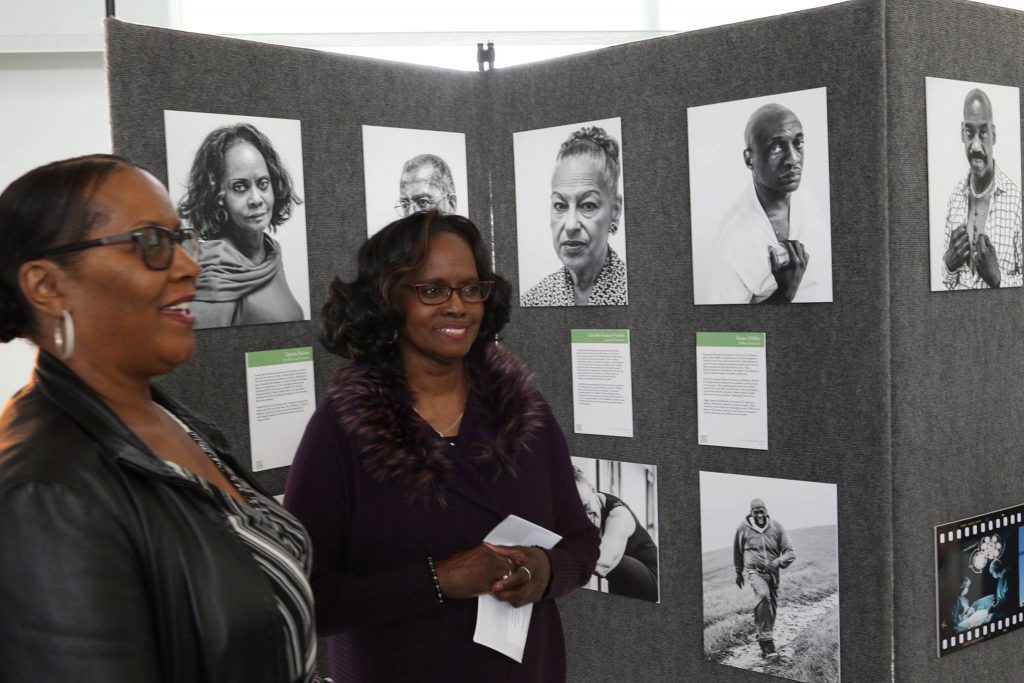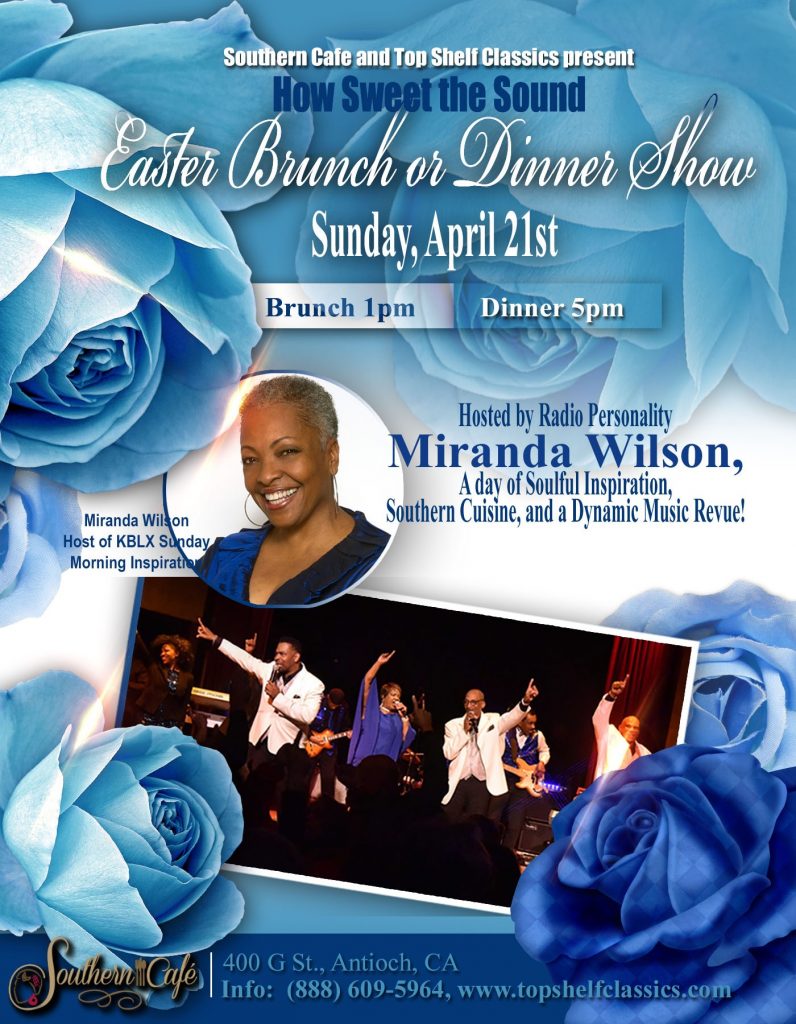Celebrate Easter at The Church @ Antioch, Sunday, April 21
Monday, April 8th, 2019


Liver recipient, Debra Harkness (left) and double lung recipient, Damita Barbee (center) of Antioch at the opening of the exhibit on Friday, April 4, 2019. Photo by Donor Network West.
The “Giving Me Life: A Visual Journey of African-American Organ and Tissue Transplant Recipients” art exhibit has officially opened at the Alameda Health System (AHS)-Highland Care Pavilion Lobby. AHS has partnered with Donor Network West, the organ and tissue recovery organization for Northern California and Nevada, to bring “Giving Me Life” to AHS. The exhibit underscores the need for more registered donors within the African-American community through social documentary. April is Donate Life Month and the exhibit will be on display at Highland until April 30.
Antwone Johnson, the brother of organ donor Anthony Johnson, gave a very emotional testimony at the ribbon-cutting ceremony on April 4.
“I lost my brother about a year ago at Highland Hospital. He died unexpectedly after experiencing seizures that sent him into cardiac arrest. When I was first approached about donating his organs I was not interested, but as I sat in the hospital, I reflected on the fact that he was the kindest person I ever met. He would give you his last dollar without knowing where his next one was coming from. I joke that I hope the cruelest, corrupt person received my brother’s heart because there is no way they can continue to be unkind with a piece of Tony in their body.”
In addition, Johnson shared that he is humbled to be able to save someone else’s life through his decision to donate his brother’s organs.
Currently, African-Americans make up 5% of the 13 million people in Donor Network West’s donation service area, however, they represent 10% of those waiting for organ transplants in the region. The exhibit is a visual testimonial of nine local African-American transplant recipients who have overcome incredible obstacles in their respective journeys toward health and wellness thanks to organ and tissue donation.
“We are pleased to collaborate with Alameda Health System to bring the Giving Me Life exhibit to Highland Hospital in Oakland, which boasts a proud legacy of African-American culture, art and social justice. We deeply respect Alameda Health System’s commitment to promoting healthy equity and access for all patients, 30% of whom are African-American. Our hope is to spark new conversations, and inspire more African-Americans to register as organ donors,” said Janice F. Whaley, Chief Executive Officer of Donor Network West.
Damita Barbee, a double-lung transplant recipient from Antioch, and one of the people featured in the Giving Me Life exhibit will be traveling to Italy this year, something she was not able to do five years ago. She was diagnosed with pulmonary fibrosis, but is now thriving. In her spare time she shares her story with others, hoping to encourage as many people as possible to become registered donors.
“I am very passionate about finding solutions that will help our patients live healthy lives. There are many people on the transplant waiting list and this exhibit is a great way to raise awareness about the need,” said Luis Fonseca, AHS Chief Operating Officer and Donor Network West board member.
About 50 people attended the event. Participants included Donor Network West Ambassadors, transplant recipients, donor families, AHS staff, community members, and representatives from Congresswoman Barbara Lee and Assembly Member Rob Bonta’s office.
Nearly 1,400 people are waiting for an organ transplant in Alameda County. One organ donor can save the lives of up to eight people and a tissue donor can heal 75 others. Anyone can register as a donor at DonorNetworkWest.org or at the DMV.
About Donor Network West
Donor Network West is the federally designated nonprofit, 501 (c) (3) organ and tissue recovery organization that serves 13 hospitals and more than 500,000 people in Northern Nevada. Established in 1987, the organization saves and heals lives by facilitating organ and tissue recovery for transplantation and research. Donor Network West is accredited by the Association of Organ Procurement Organizations (AOPO) and the American Association of Tissue Banks (AATB) and partners with the Department of Motor Vehicles and the state-authorized donor registry. For information, visit DonorNetworkWest.org and follow us on social media: @mydnwest
 Dear Editor:
Dear Editor:
My friends thought I was crazy to move my wife and five children to Antioch three years ago. I can’t blame them. I read the headlines, and I know what people think of our city. But I also know that everything is not as it seems.
Our move to Antioch worked out great. We live in a large, beautiful home on a quiet street. Our neighborhood, like our city, is extremely diverse, and I’m grateful that my kids aren’t growing up among clones of themselves. We know our neighbors and they’re wonderful. Our two youngest boys attend Carmen Dragon Elementary School and love it.
However, I realize my experience is not like everyone else’s. As a vice president of a public relations and marketing firm, I’m fortunate to work from home, so I’m around my kids constantly. Many Antioch parents do not have this opportunity, which means their kids often come home to empty houses—or they find somewhere else to go or something else to do.
As a member of Carmen Dragon’s school site council, I learned Carmen Dragon is a low performing school with a chronic student absentee problem and a host of other challenges. Nearly three-quarter of my sons’ classmates come from socio-economically disadvantaged households. Yet there is no afterschool program at Carmen Dragon or at many other schools in the district.
I’ve also learned many kids in Antioch want to play sports, but their parents cannot afford to take time off work to take them to practices or games, let alone volunteer or coach.
When we signed our boys up for CYO basketball, they weren’t going to play unless I volunteered to coach both of their teams. When I did, I discovered nearby parishes have multiple teams at each grade level. But at our parish, some grades didn’t even have a team. In fact, there is only one girls’ team for the entire parish.
This is a huge difference from Concord, where we used to live. Every school our children attended had afterschool programs. Concord also has the Community Youth Center, an enormous facility that offers all types of programs, including wrestling, cheerleading, gymnastics, tutoring for grade schools and high schools, and more. It’s super cheap and open every day until 9pm. Our three older kids, who attended school in Martinez and Pleasant Hill, had access to a Boys and Girls Club and a YMCA, which were always full of kids and activities.
Antioch has nothing like these facilities. What we do have is a large community center on Lone Tree, across the street from Dear Valley High School. It has a gym, a full-service kitchen, a ballroom and an amphitheater. It should be filled with kids every day. Yet it is often empty after 5:00 p.m., when many parents are getting off work and just beginning their long commute home.
After three years here, it’s become evident that Antioch is failing its youth. Is it really any wonder why we have higher crime rates than other cities? We can hire police officers until we’re blue in the face—no pun intended—but this won’t prevent our young people from behaviors and influences that lead to trouble.
So, what does help? Study after study has proven the availability of structured, daily afterschool programs, Boys and Girls Clubs and community-based organizations targeting at-risk youth are effective at reducing crime. District attorneys, police chiefs and sheriffs across our nation support these programs because they actually improve public safety.
According to a massive, nationwide study by the Council for a Strong America, a bipartisan nonprofit comprised of law enforcement officials, military and business leaders, pastors, coaches and athletes, afterschool programs save communities at least $3 for every $1 invested by increasing a child’s future earning potential, improving their performance at school and reducing crime and welfare costs.
Recently, I sat in on a Antioch Youth Services Task Force meeting and listened to young people say they don’t feel safe at school or in the community. They want more things to do, but our city just doesn’t offer them.
I’ve also sat in on city council meetings and listened to how people thought we should spend Measure W funds. Some folks want all of the money to go toward adding more police. But until we invest in our youth, we will only be able to react to crime, not prevent the causes of it.
At the April 9th Antioch City Council meeting, citizens have a chance to tell city leaders how to allocate $14 million in Measure W money. Please show up and ask them to invest in afterschool programs, a Boys and Girls Club and juvenile crime diversion programs. Our kids’ lives depend on it.
Warren Lutz
Antioch

The California Geological Survey (CGS) has released five official Seismic Hazard Zones maps affecting communities in Contra Costa and San Mateo counties. The maps identify areas with potential for earthquake-induced landslides and liquefaction, and come with certain requirements for landowners and local governments.
There are three maps covering parts of Contra Costa County, including all or portions of the communities of Antioch, Concord, Brentwood, Oakley, Pittsburg, and Bay Point.
There are two new maps impacting San Mateo County, including all or portions of the communities of Woodside, San Carlos, Belmont, Burlingame, Half Moon Bay, Hillsborough, Millbrae, Redwood City, San Bruno, San Carlos, Portola Valley, and Pacifica.
Earthquakes of magnitude 5.5 or greater can trigger landslides or liquefaction, a phenomenon in which soil temporarily acts like quicksand and loses its ability to support structures. While shaking does most of the damage in a large earthquake, both liquefaction and landslides caused significant damage during the 1989 Loma Prieta quake. The Seismic Hazards Mapping Act mandating the regulatory maps was passed the year after Loma Prieta.
The maps establish Earthquake Zones of Required Investigation. Now that these maps are official after a 6-month public comment period, the local building department must require — before permits are issued — that licensed geologists and engineers investigate sites proposed for development within a zone for evidence of liquefaction or landslide potential. If such evidence is found, design modifications must be made in the planning stage. Examples of these modifications include deep foundations in liquefaction zones or slope stabilization in landslide zones.
Property sellers and real estate agents must inform potential buyers if property they’re selling is in a Seismic Hazard Zone, as is the case when property is in a designated flood zone.
List of Official Maps and Reports released April 4, 2019
The index maps below show the general areas in Contra Costa and San Mateo counties affected by this release.
The maps are available as GeoPDF files, which can be viewed using Adobe Acrobat Reader; a GeoPDF file consists of multiple layers and gives the user greater flexibility in viewing and displaying the maps. The maps are also available as digital Geographic Information System (GIS) files. GIS files for both AP Earthquake Fault Zones and Seismic Hazard Zones released by CGS are considered Official Maps. To obtain these maps, reports and GIS data, visit the Regulatory Maps and Reports section of the CGS Information Warehouse. To view individual parcels affected by Seismic Hazard Zones and/or Earthquake Fault Zones, visit our Earthquake Hazards Zone Application (“EQ Zapp”).


 Services for the Home Going Celebration for Destinee S. Jenae Hillery
Services for the Home Going Celebration for Destinee S. Jenae Hillery
Thursday April 4, 2019
11:00 am
New Destiny Church
1411 E. Leland Rd
Pittsburg, CA 94565
Repast to be held at:
Pittsburg Senior Center
300 Presidio Lane
Pittsburg, CA 94565

An example of the creative for the City’s new branding campaign.
By Kwame Reed, Director of Economic Development, City of Antioch, CA
The City of Antioch today unveiled a major advertising campaign to elevate the City’s new brand promise that “Opportunity Lives Here.” The campaign, which was developed by San Francisco-based agency Evviva Brands will run across social, paid, outdoor and transit corridors connecting Antioch with other Bay Area cities.

New Antioch City logo and slogan.
The campaign features the many facets of opportunity Antioch provides, from expansion opportunities available for Bay Area businesses seeking a skilled, diverse talent pool and affordable, transit-accessible commercial real estate to the wide range of lifestyle opportunities Antioch offers.
The campaign will drive traffic to a new, opportunity-focused campaign site at www.AntiochIsOpportunity.com, where visitors can learn more about business opportunities, lifestyle opportunities, the advantages of Antioch’s reverse commute, and Antioch’s welcoming and vibrant community.
The goal of the campaign is to provide Bay Area residents with a more accurate, up-to-date view of the City of Antioch. From its beginnings as a landing on the San Joaquin River in 1848, Antioch has been a city of opportunity longer than California has been a state. And with increasing numbers of businesses and residents fleeing the high costs and development restrictions elsewhere in the Bay Area, Antioch may be the last Bay Area city offering opportunity for all.
“I’m thrilled to launch this campaign. With our new BART station, the massively improved Highway 4, our AMTRAK service and being the midpoint location between San Francisco, Sacramento, and the Central Valley, I look forward to welcoming businesses and visitors to the land of opportunity that is Antioch,” says Mayor Sean Wright.
“Antioch has always been the home of opportunity. We’ve always been a place for builders, for doers, for people who just want a chance to show what’s possible. This campaign speaks to them, because it’s for them,” says Economic Development Director Kwame Reed. “Antioch is the center of a mega-region that stretches from the Sacramento Valley to the Silicon Valley and from the Central Valley to the Greater Bay Area, Opportunity Lives Here,” Reed said.
“This campaign has been a joy to create,” says David Kippen, CEO of Evviva Brands. “From our first days working in Antioch, we’ve been amazed by the variety and the diversity of opportunities the City has to offer. Antioch has been the Bay Area’s best kept secret. As of today, the secret’s out.”
You can learn more about the campaign by visiting the campaign website at www.AntiochIsOpportunity.com or by calling Kwame Reed at the number listed above.
Following are more examples of the campaign’s creative:

